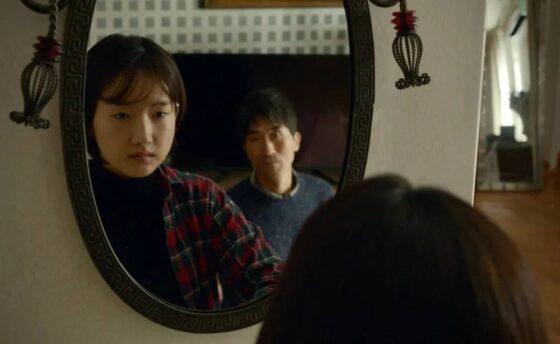Rituals and Reciprocity: Albert Shin’s Together

By Winnie Wang
In Hong Sangsoo’s Tale of Cinema (2005) a depressed young man reunites with a female former classmate through a chance encounter and joins her after a night of emotional conversations and heavy drinking in an impulsive suicide pact. In a hotel room, the two take turns swallowing sleeping pills collected from pharmacies across Seoul, and eventually fall unconscious. Hours later, the young woman wakes up first and notifies the man’s family of his condition by phone before fleeing the scene—an act that saves his life. When, one cut later, an auditorium door suddenly opens and we see audience members file out of a theatre, this life-or-death melodrama is revealed to be a clever mise en abyme—a short film playing at a cinematheque retrospective.
Given the premise of Hong’s film-within-a-film, it would seem easy to connect Tale of Cinema to Albert Shin’s short Together, in which an unnamed young woman (Ahn So-yo) and an older man (Kim Jae-rok), known to each other only by their online aliases, similarly meet in a motel room. They’re complete strangers on either side of a substantial age gap, but they share the same self-destructive goal, with a toxic variation on the exact method of self-harm: carbon monoxide poisoning. After excessively consuming soju to the accompaniment of Shin Joong Hyun’s “Beautiful Rivers and Mountains”—perhaps to pass the time or gain liquid courage—they collapse on the makeshift beds that they have set up on the ground. In Shin’s film, as in Hong’s, the girl wakes up first. Both relieved and horrified by the events that transpired the previous night, she turns off the portable gas stove burning charcoal and waits for the first sign of movement from her co-conspirator, before escaping outside and gazing into the dawn.
Where Tale of Cinema removes the stakes of suicidal ideation with its self-reflexive narrative framing, and also provides moments of levity with failed scenes of intimacy and a melodramatic family intervention, Together earnestly pursues the subject of self-willed death with sustained attention. After learning about internet suicide pacts in South Korea while filming his breakthrough feature In Her Place (2014), Shin became fascinated by the phenomenon. As its title suggests, Together is about sharing an experience: the paradox of why lonely people driven to despair by their isolation choose to align in their final moments. The lack of proper names in the film isn’t just a narrative conceit, but a sort of thesis: How does anonymity construct the promise of a safe space or liberation? What does this fatal ritual grant its participants? The film is a meditation on these questions, probing the subjectivities of its characters in search of insight, if not answers.
Though it would be easy to say that Together is “about” this disturbing phenomenon, which might veer into moralizing—or worse, educational—territory, the film is instead concerned with the precarious and fleeting relationship between strangers. He asks about her age and what she might write as a farewell note; she asks how long he thinks the process will take. Shin forces us to extrapolate backstory from minimal details: knowing only the pair’s online usernames and what they ate yesterday, we extrapolate the types of lifestyles they might have had until this point of convergence. Each intricacy, from the way she grasps a writing instrument to his satisfied smile over the mention of a marbled sirloin, casts light upon concealed histories. For this reason, Shin succeeds in establishing characters that induce a deep exhale of relief when we learn that they’ll emerge from their tape-sealed confines to live another day.
Typically, cynicism is the prevailing response to societal collapse. Shin frees us from this outlook with a conclusion that makes a case for reciprocal care and vulnerability. Bound by the rules of their pact, the girl believes that their agreement stands equally for life as it does for death, and, without hesitation, ensures their survival after she wakes up still alive. Failure, in this instance, is a triumph. In the last shot, her hair gently blows in the breeze as she leans against the protective barrier of the balcony, a sunrise in the background. We don’t see her expression—Shin understands that a closing, contemplative look is a visual platitude. But we still gather a sense of it through a stark aural transition from the deadened air of the room to the soundscape of the tranquil seaside. This carefully concealed ending opens up new horizons of possibility.
Together screens with Hong Sangsoo’s Introduction at TIFF Bell Lightbox on Thursday, July 28 as part of MDFF Selects: Presented by Cinema Scope and TIFF.
Winnie Wang

